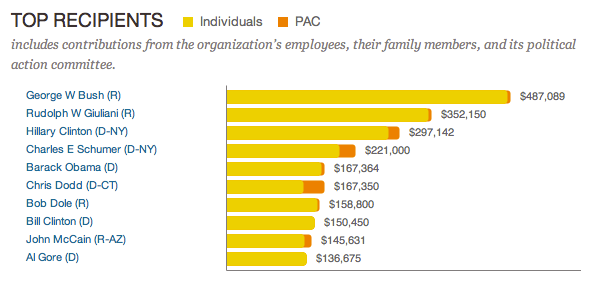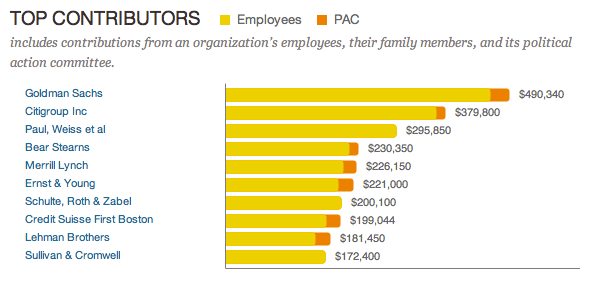In Depth with Campaign Finance Data
Introduction
Influence Explorer and TransparencyData are the Sunlight Foundation’s two main sources for data on money and influence in politics. Both sites are warehouses for a variety of datasets, including campaign finance, lobbying, earmarks, federal spending and various other corporate accountability datasets. The underlying data is the same for both sites, but the presentation is very different. Influence Explorer takes the most important or prominent entities in the data–such as state and federal politicians, well-known individuals, and large companies and organizations–and gives each its own page with easy to understand charts and graphs. TransparencyData, on the other hand, gives searchable access to the raw records that make up each Influence Explorer page. Influence Explorer can answer questions like, “who was the top donor to Obama’s presidential campaign?” TransparencyData lets you dig down into the details of every single donation to that campaign.
Every chart and figure in Influence Explorer is derived from the detailed records in TransparencyData. But correctly computing totals from the raw records isn’t always straightforward. As an example of the steps necessary to derive the totals in Influence Explorer from the raw records in TransparencyData, we’ll look at contributions from the accounting firm Ernst & Young to Senator Chuck Schumer. We’ll use Ernst & Young and Schumer because the data happens to include a lot of illustrative examples, not because of any specially meaningful relationship between the two.


According to Influence Explorer, Ernst & Young has given $221,000 to Schumer. The $221,000 figure can be seen on both Ernst & Young’s page and Schumer’s page. To see the raw records that make up this sum, you can search TransparencyData for contributions with ‘Schumer’ as the recipient and ‘Ernst & Young’ as the organization. You should see a page like this. If you download the data and open it in a spreadsheet program such as Excel, you’ll be able to see details for every contribution. Summing up the ‘contribution_amount’ column for all 242 rows gives a total of $227,500. This is $6,500 more than is listed in Influence Explorer. The rest of this article will explain how the final figure of $221,000 is arrived at, and along the way show some of the intricacies of campaign finance rules and limitations of the data.
Transaction Types and Contributor Categories
Our campaign finance data comes from the Center for Responsive Politics (CRP), which in turn gets its data from the Federal Election Commission (FEC). The FEC tracks a wide variety of financing, categorizing every contribution into one of 68 transaction types. In Influence Explorer we’re only interested in straightforward contributions from individuals or Political Action Committees (PACs) to candidates. We don’t track money that goes from one PAC to another or from party committees to candidates, and we don’t track various more esoteric accounting measures, such as money that’s rolled over from one election cycle to the next. The only FEC transaction types we include are the following: 10, 11, 15, 15e, 15j and 22y (for contributions from individuals) and 24k, 24r and 24z (for contributions from PACs). This list of categories was adopted primarily to maintain consistency with CRP’s methodology. If you’re interested in some less common forms of contributions you may want to compute the sums yourself using a different set of transaction types.
To match Influence Explorer’s totals in the Ernst & Young example there’s only one row that needs to be excluded: row 200, transaction type 18j. (18j indicates that the contribution was already reported elsewhere as part of another contribution.)
In addition to excluding transactions based on their type, transactions are also excluded based on the category of the contributor. Contributor categories are codes assigned by CRP that usually encode the industry of the company, but also encode special cases like party committees, candidate self-financing and unitemized contributions. A full list of category codes is available here. For Influence Explorer we exclude all records with contributor_category starting with Z, except for Z90s (candidate self-financing), which are included. In this example there are no Z contributions.
Identifying Corporations and Their Subsidiaries
Another set of concerns relates to how an organization or its parent organization is labeled in the data. TransparencyData search results will include all records that contain the words you search on–in this case the words ‘Ernst’ and ‘Young’. The Influence Explorer totals, on the other hand, are based only on records where organization_name or parent_organization_name exactly matches “Ernst & Young”. The stricter matching in Influence Explorer makes sense, since we don’t want to erroneously include a record. In TransparencyData the more permissive matching is useful, since the user has a chance to look at each record and decide what is relevant.
A contributor’s employer information, as submitted to the FEC by the contributors themselves, is listed in the field labeled contributor_employer. This information is not standardized in any way. Some of the variations in this column for these search results include “ERNST & YOUNG”, “ERNST & YOUNG LLP” AND “ERNST & YOUNG, LLP”. To make the data more useable, CRP has undertaken the significant task of standardizing the many variations of organization names. The standardized name assigned by CRP is listed in the organization_name column. CRP also adds information on corporate relationships by listing any parent company in parent_organization_name. Our example data shows several rows where Ernst & Young is listed as the parent company. These records will be included in the Influence Explorer totals for Ernst & Young, even when the original contributor_employer didn’t directly mention Ernst & Young.
This standardization process is unfortunately not perfect or complete. For example, in row 7 you’ll see that the original Update: CRP informs us that this is not an error. Although the individual had listed Ernst & Young as his employer, CRP researchers determined through lobbying records that the individual also worked for Akin, Gump et al, and that this was a more appropriate assignment. Errors can also run the other direction, causing contribution to be included where they should not be. Examples of this are found in rows 124 and 179, which have ‘CAP GEMINI ERNST & YOUNG’ in the original contributor_employer is listed as “WASHINGTON COUNCIL ERNST & YOUNG”, but CRP has erroneously standardized the name to “Akin, Gump et al”. Because of this error, the $1000 contribution will not be included in Influence Explorer’s totals for Ernst & Young.contributor_employer field. Cap Gemini Ernst & Young is actually a separate firm, sold off from Ernst & Young in 2001. But the field has been standardized to ‘Ernst & Young’, so the two contributions will show up in Influence Explorer’s Ernst & Young totals. Update: CRP has since corrected this error. If you notice errors in the data yourself, CRP happily accepts corrections.
Both CRP and Sunlight Foundation work hard to find an eliminate errors, but with over 40 million campaign finance records, this will always remain somewhat of a work in progress. Despite the occasional flaws, this data is still an enormous improvement over what’s available directly from the FEC or any other source.
Other Considerations
Within the field of campaign finance reporting, it is standard practice to determine the total amount a company gave by grouping contributions from employees together with contributions from the company’s PAC. This is a necessary simplification, but it ignores the reality that not all employees are giving because of their corporate affiliation, and not all candidates will view every contribution from an individual as being representative of individual’s employer. If you are only interested in direct contributions from the corporation’s PAC then you can limit the records you consider to those with contributor_type of C (for committee).
It is also worth noting that CRP, and therefore Influence Explorer, counts the contributions of immediate family members towards the organization. An example of this can be seen in row 205, where Patricia Laskaway (occupation homemaker) is listed as affiliated with Ernst & Young by virtue of Phillip Laskaway (occupation Ernst & Young LLP).
Finally, the FEC only requires itemized disclosure of contributions from donors that gave more than $200 in an election cycle. So the $221,000 from Ernst & Young to Schumer doesn’t include any money that came from smaller donors.
More Resources
This is only a brief introduction to a complex field. More information on the data itself is available from our data providers. For federal campaign finance and lobbying data this is CRP, which in turns gets its data from the FEC. More details on our handling of the data are available on the Influence Explorer methodology pages for campaign finance and lobbying. For information on sources and methodology for our other data sets see the Influence Explorer About page.
If you have any questions or comments we’d love to hear from you.


